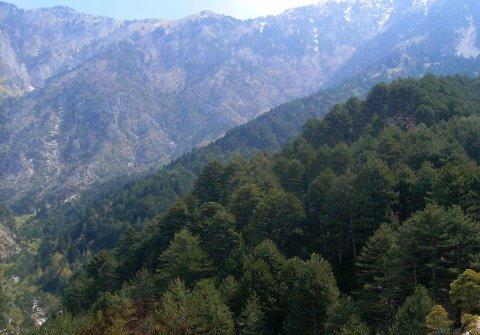Forests
Albania is a rich country with forest and pastures. The forest land cover about 1.030.000 ha or 36% of the national territory and the pastures cover about 400.000 ha or 15%. On the basis of the forest functions Albania have 848.640 ha production forest and 209.000 ha protected forest. There are 4 phytoclimatic areas in
Albania as a result of the several factors as the land, climate, and vegetation, named: forest zone and the Mediterranean shrubs, oak zone, beech and conifer zone, and the alpine pastures.
Most of the forests are concentrated in the North-East and South- East of the country. On the broad-leafed forest the bigger surface is covered by the oak with 32% of the forest surface, followed by the beech forest with 17% and other broad-leafed plants with 9%. On the conifer the bigger surface is covered by the black pine with 11% of the forest surface. From the shrubs the strawberry tree have the broad surface, and after hornbeam, heather, boxwood, hazelnut, willow, etc.
The coastal forests are dominated from the Mediterranean pine: the Aleppo pine (Pinus halepensis), Italian stone pine (Pinus pinea), cluster pine (Pinus marittima), and from other plants as Ammophila arenaria, Elymus farctus, Calystegia soldanella, etc. The alluvional natural forest on the coast represent typical hygrophyle
forest surface distributed on the river mouth, over alluvional land mainly alkaline, with high level of underground water and flooded frequently from the river water or strong raining. This forest are composed by very divers ecosystems and with basic elements of European cosmopolite plants as European black alder (Alnus
glutinosa), narrow-leaved ash (Fraxinus angustifolia), oak (Quercus robur), white poplar (Populus alba), elm (Ulmus minor), etc.
The flora of the oak evergreen forest is presented by the forest of Holm oak (Quercus ilex), Pistacia lentiscus, Pistacia terebinthus, Rosa sempervirens, Erica arborea, etc.The flora of half not evergreen oak is composed by Macedonian oak (Quercus trojana), Valonia oak (Quercus macrolepis), white oak (Quercus pubescens), plane trees (Plantanus orientalis), prickly juniper (Junuperus oxycedrus), etc. The flora of other forest of oak with falling leaves and the chestnut is formed by the bung forest (Quercus petraea), forest of Italian oak (Quercus frainetto), Adriatic oak (Quercus cerris) and the mix oak forest with Fraxinus ornus, Carpinus orientalis, Juniperus oxycederus, Lembotropis nigricans, Crataegus ssp., etc.
The flora of beech forest include forest with black pine (Pinus nigra), beech (Fagus sylvatica), fir (Abies alba), Heldreich pine (Pinus leucodermis), Pinus mugo, Pinus peuce, Populus tremula, Quercus pubescens, etc. Interesting is also the flora grown in the glacial hole, in carbonated slopes, etc., where endemic and sub-endemic plants or Balkan species as Ligusticum albanicum, Lilium albanicum, Lunaria telekiana, Cistus albanicum, etc. The study shows as 306 plant species are under risk (based on government decree, 2003), from which 73 are forest plants that make 10% of Albanian flora. In High Mountain are found about 52 thousand ha of natural and semi natural forest, with tree of 200 years old, with high biodiversity value. Perhaps, these are the most important forest surface for research and genetic resources.

